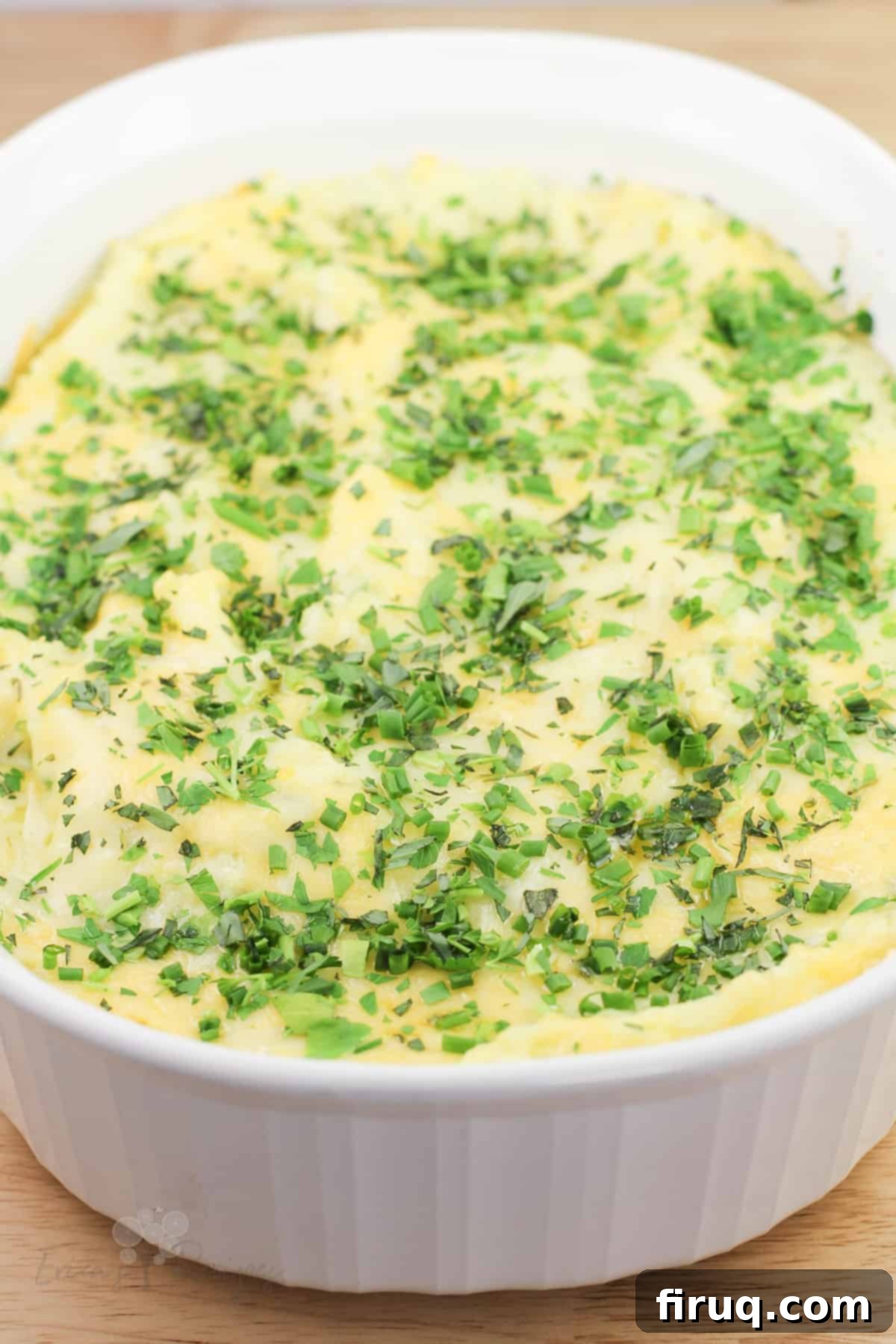Indulgent Gruyere & Gouda Mashed Potatoes: A Garlic and French Fine Herb Delight
Prepare to elevate your side dish game with these incredibly luxurious Gruyere, Garlic, and Gouda Mashed Potatoes. Infused with aromatic French fine herbs, rich butter, and luscious cream, these cheesy mashed potatoes are more than just a complement; they’re a showstopper. The harmonious blend of creamy Gouda and nutty Gruyere cheeses creates an unparalleled depth of flavor and a wonderfully smooth texture that will leave everyone craving more.
The inspiration for this magnificent recipe actually struck during a casual moment. My husband, ever the keen observer, captured a photo of a restaurant menu during a trip to Nashville, Tennessee. The combination of Gruyere and Gouda, alongside garlic and French fine herbs, instantly captivated my culinary imagination. I knew immediately that I had to recreate – and perfect – this tantalizing blend in my own kitchen.
Whether you’re a seasoned chef or just starting your culinary journey, this guide will walk you through every detail of crafting these AMAZING mashed potatoes. We’ve included a wealth of tips and tricks to ensure your success. Experienced cooks can use the “Jump To Recipe” button above to swiftly navigate to the concise recipe card, while those who appreciate a deeper dive into techniques and insights can read on.
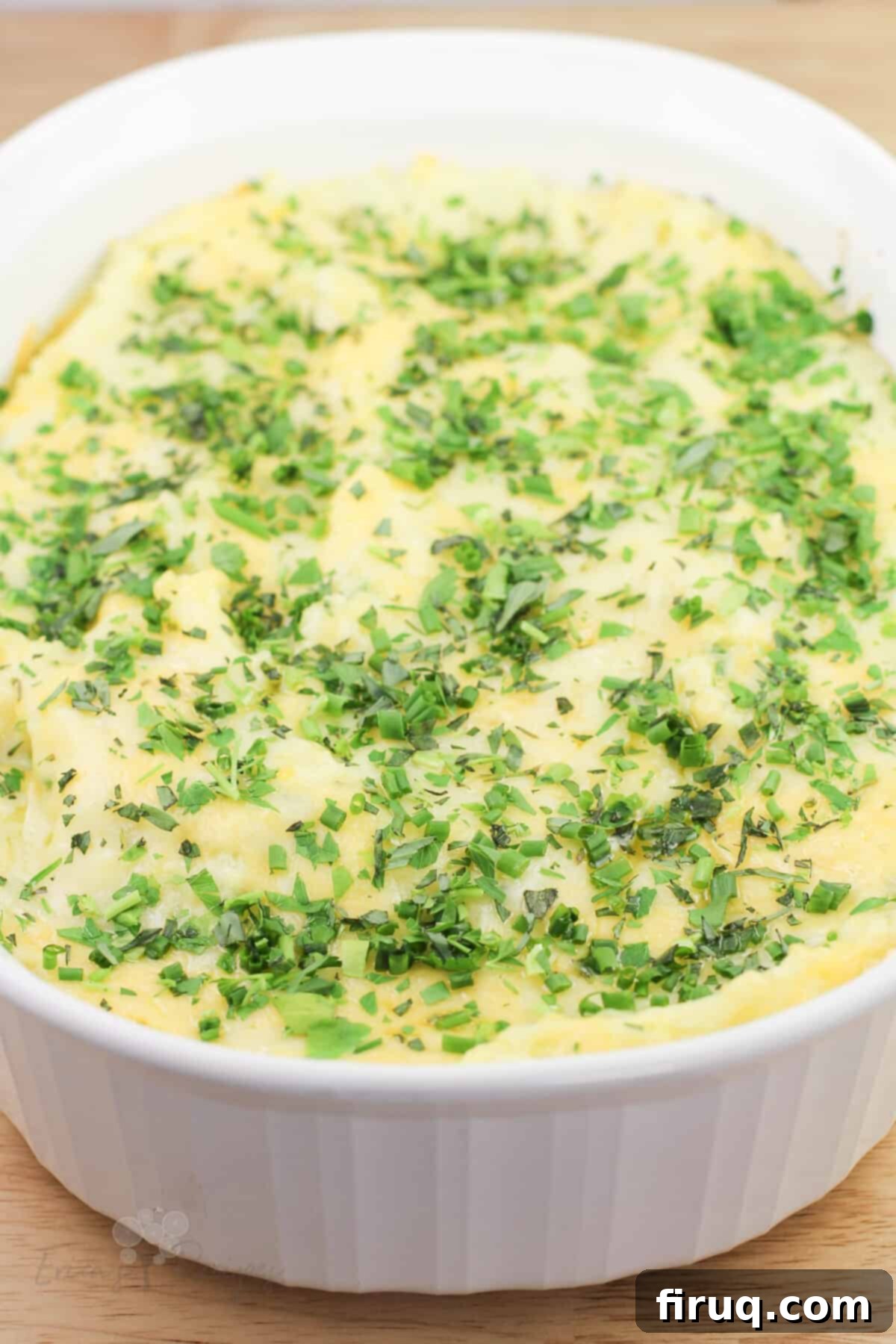
The Irresistible Allure of These Cheesy Mashed Potatoes
There are countless reasons why these Gruyere, Garlic, and Gouda Mashed Potatoes will become a staple in your recipe collection. They offer an experience that transcends the ordinary, transforming a humble potato side into a gourmet delight.
An Explosion of Flavor
First and foremost, it’s the sheer “flavor bomb” of cheesy mashed potato goodness. Imagine the robust, earthy notes of Gruyere dancing with the sweet, creamy undertones of Gouda, all perfectly balanced with pungent garlic and the delicate freshness of French fine herbs. Add to this rich, unsalted butter, a generous splash of heavy cream, and just the right touch of kosher salt, and you have a symphony of tastes that is truly AMAZING. Each spoonful delivers a velvety, savory, and aromatic experience that is incredibly satisfying.
Elegance in Presentation
Beyond the incredible taste, these mashed potatoes are a feast for the eyes. What might seem like a simple potato dish is elevated into something truly special. The name itself – Gruyere, Garlic, and Gouda Mashed Potatoes – sounds sophisticated. But it’s the vibrant addition of fresh, finely chopped herbs as a garnish that really makes these potatoes shine. Fresh herbs don’t just add a burst of flavor; they also contribute a pop of color and an air of elegance, making any dish look extra special and ready for a celebratory table.
Surprisingly Simple to Prepare
Despite their gourmet appeal, these cheesy mashed potatoes are remarkably easy to make. Mashed potatoes are a beloved comfort food precisely because of their delightful taste and straightforward preparation. This recipe adheres to that principle, ensuring that even with premium ingredients, the process remains approachable for home cooks of all skill levels. We’ve streamlined the steps so you can achieve restaurant-quality results without unnecessary complexity, checking the “easy and delicious” box with confidence.
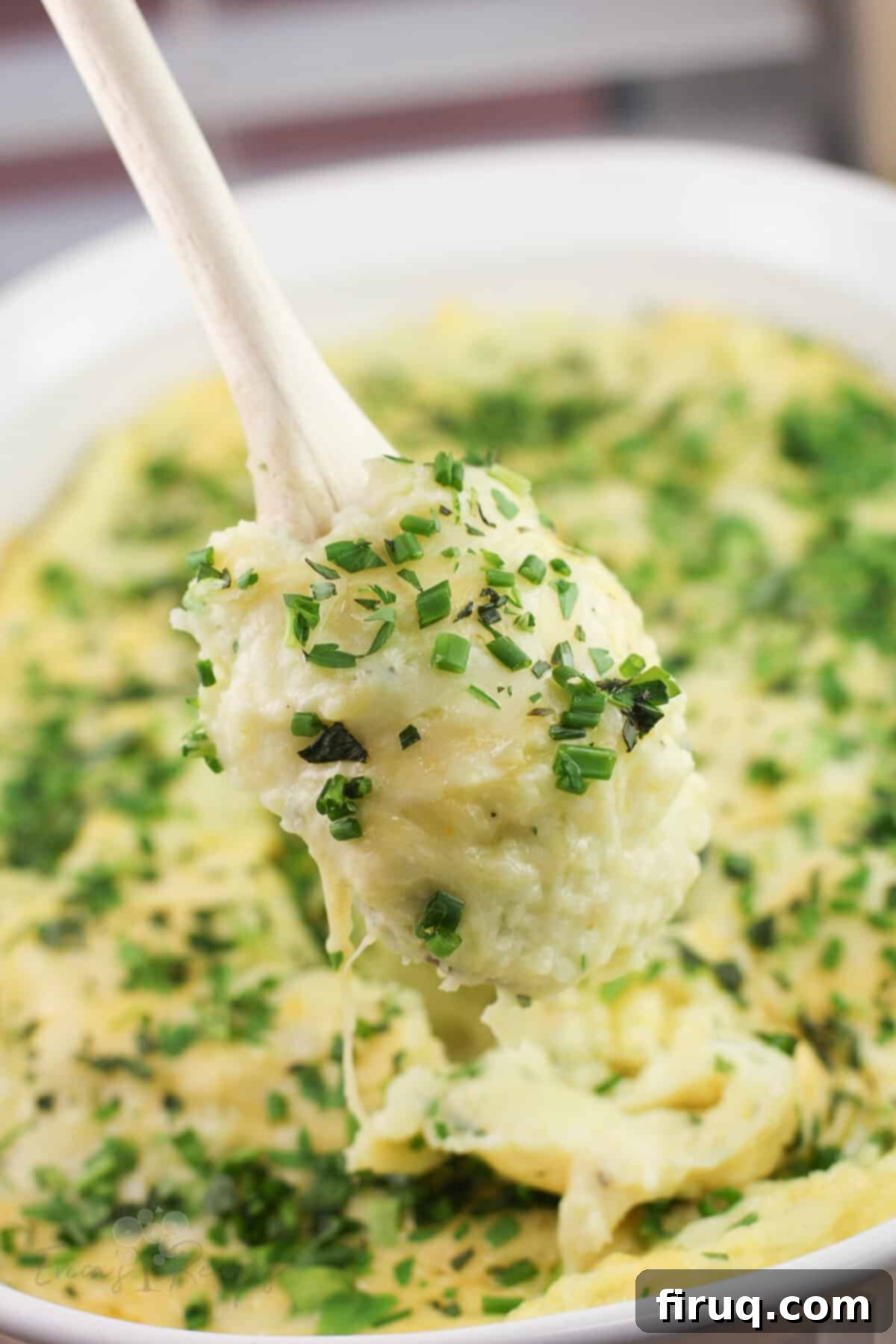
Understanding French Fine Herbs: A Delicate Blend
I’ve mentioned ‘fine herbs’ quite a bit, so let’s clarify what they are and why the “French” distinction is important for this recipe. French fine herbs refer to a classic blend of delicate, fresh herbs traditionally used in French cuisine. This specific mix typically consists of equal parts parsley, chervil, tarragon, and chives.
The key characteristic of fine herbs is their mild, nuanced flavor, which enhances rather than overwhelms a dish. Stronger, more assertive herbs like oregano or basil are intentionally excluded from this traditional blend. However, other delicate fresh herbs, such as marjoram, thyme, or watercress, can sometimes be incorporated or substituted depending on availability and desired nuance.
For these particular Gruyere, Garlic, and Gouda mashed potatoes, I opted for a trio: fresh flat-leaf parsley, chives, and tarragon. While chervil is a traditional component, it can be challenging to find in mainstream U.S. grocery stores. Given that chervil belongs to the parsley family and possesses a similar, albeit more subtle, flavor profile, using high-quality flat-leaf parsley as its stand-in works perfectly without compromising the integrity of the dish. There’s no need to stress over the fourth herb when the available three create such a wonderful aroma and taste.
An important note on parsley: always opt for flat-leaf (Italian) parsley in your cooking. Its clean, slightly peppery flavor is far superior to curly parsley, which often tastes bland or even grassy. This small detail makes a significant difference in the overall freshness and flavor of your fine herb blend.
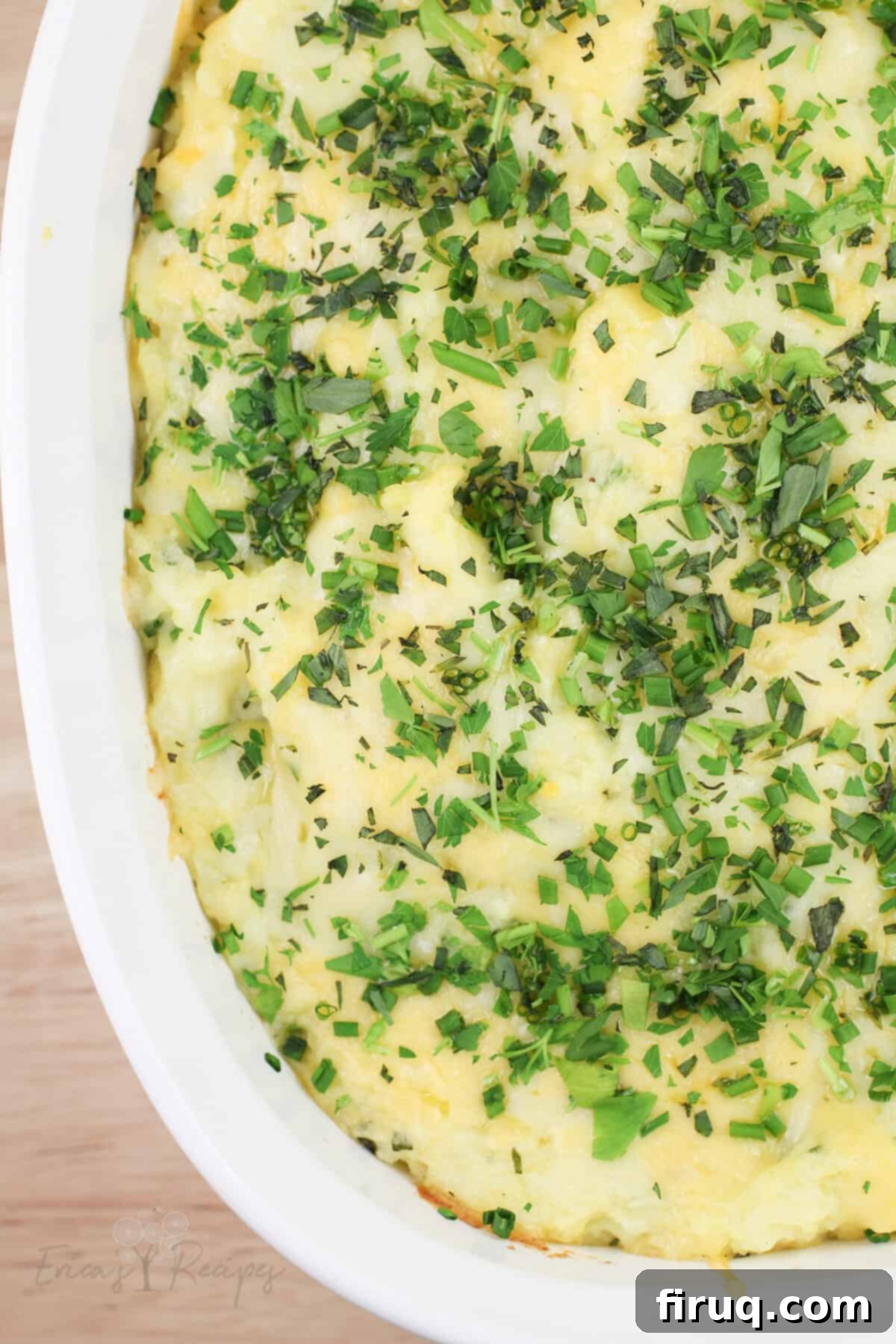
The Perfect Duo: Why Gouda and Gruyere Are Essential
The secret to the extraordinary cheesiness in this mashed potato recipe lies in the masterful pairing of Gouda and Gruyere. While both are cow’s milk cheeses, they are distinctly different, and their combined characteristics create a truly magical experience.
Gouda is a semi-soft, yellowish cheese originating from the Netherlands. Known for its smooth, creamy texture and a delightful, slightly sweet flavor with subtle nutty undertones, Gouda melts beautifully, creating a rich and velvety consistency. It’s wonderfully versatile, equally delicious sliced on crackers or melted into comforting dishes like macaroni and cheese.
Gruyere (pronounced ‘groo-YAIR’), on the other hand, hails from Switzerland, named after the town of Gruyères. It’s an aged, hard cheese with a more assertive, earthy flavor. Gruyere offers pronounced notes of fruit and nut, providing a bolder character than Gouda. While it also tastes fantastic sliced on its own, it excels in baked applications, adding a complex depth to recipes like savory popovers.
Consider the contrast: one is semi-soft, sweet, and melts with incredible creaminess; the other is firm, savory, and delivers a powerful, nutty earthiness. Together, against the comforting and neutral backdrop of mashed potatoes, these two cheeses don’t just coexist – they truly sing. Their interplay of textures and flavors elevates these mashed potatoes from a simple side to a culinary masterpiece.
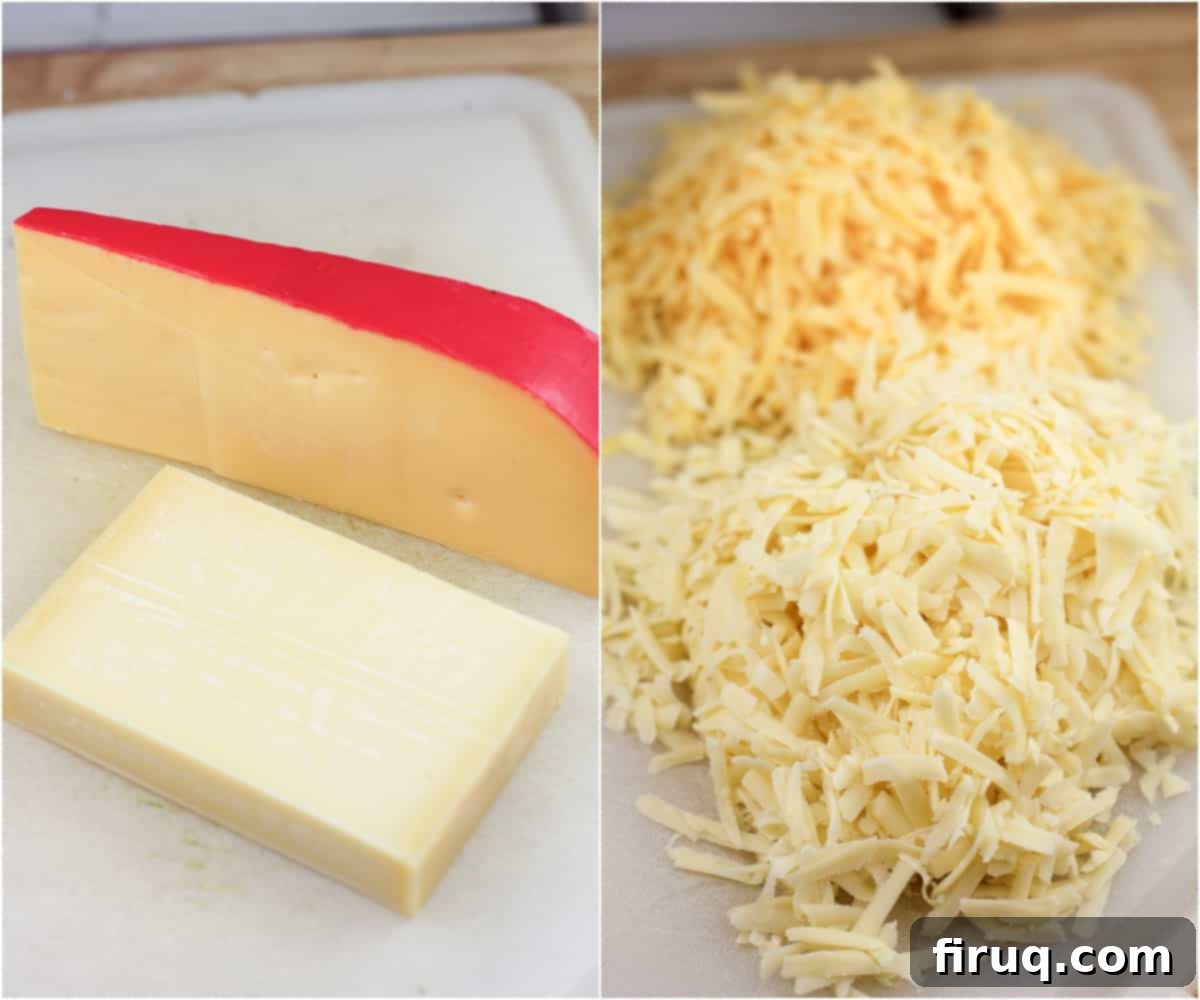
Essential Ingredients for Perfect Mashed Potatoes
Crafting the perfect batch of cheesy mashed potatoes begins with selecting the right ingredients. Each component plays a vital role in achieving that creamy texture and sensational flavor.
- Potatoes: While you can certainly use your favorite variety, I highly recommend Yukon Gold potatoes for this recipe. Their naturally buttery flavor perfectly complements the rich cheeses and herbs. Additionally, their beautiful golden flesh adds a visual appeal that harmonizes with the color of the Gruyere and Gouda. Yukon Golds also yield a wonderfully creamy and fluffy mash, ideal for this dish.
- Cheeses: As discussed, Gouda and Gruyere are the stars. Look for them in the specialty cheese section of your grocery store. A crucial tip: ensure you purchase regular, unsmoked versions of both cheeses. While smoked Gouda or Gruyere have their place in other recipes, their intense smoky flavor would overshadow the delicate balance we’re aiming for here.
- Dairy: We’re fully committing to luxurious creaminess with heavy cream, unsalted butter, and whole milk. The heavy cream adds unparalleled richness, while unsalted butter gives you control over the overall saltiness, allowing the cheese to contribute its natural brininess. Milk helps achieve the desired consistency without adding too much fat.
- Seasonings: Classic kosher salt and fresh cracked pepper are indispensable. You’ll notice the recipe calls for a modest ½ teaspoon of kosher salt, which might be less than you’d typically use in mashed potatoes. This is because both Gruyere and Gouda are naturally salty, so we start with less and adjust to taste, preventing an overly seasoned dish.
- French Fine Herbs: We’re using a fresh trio of Italian flat-leaf parsley, tarragon, and chives. Fresh herbs are crucial here, providing bright, aromatic notes that elevate the entire dish. Their delicate flavors are essential to the “French fine herbs” profile.
- Garlic: Often an understated hero, garlic brings a pungent warmth that ties all the flavors together. The recipe calls for 2 cloves, but this is entirely customizable to your preference. Feel free to adjust the amount of chopped garlic to suit your taste – more garlic means more of that wonderful, savory punch in every bite!
A special mention for tarragon: this unique herb boasts a delicious, subtle anise-like flavor. Think of it as the most delicate hint of licorice, but in an elegant, sophisticated way – reminiscent of fine French dining rather than an overwhelming candy taste. Its distinctive character adds a layer of complexity that beautifully enhances these potatoes.
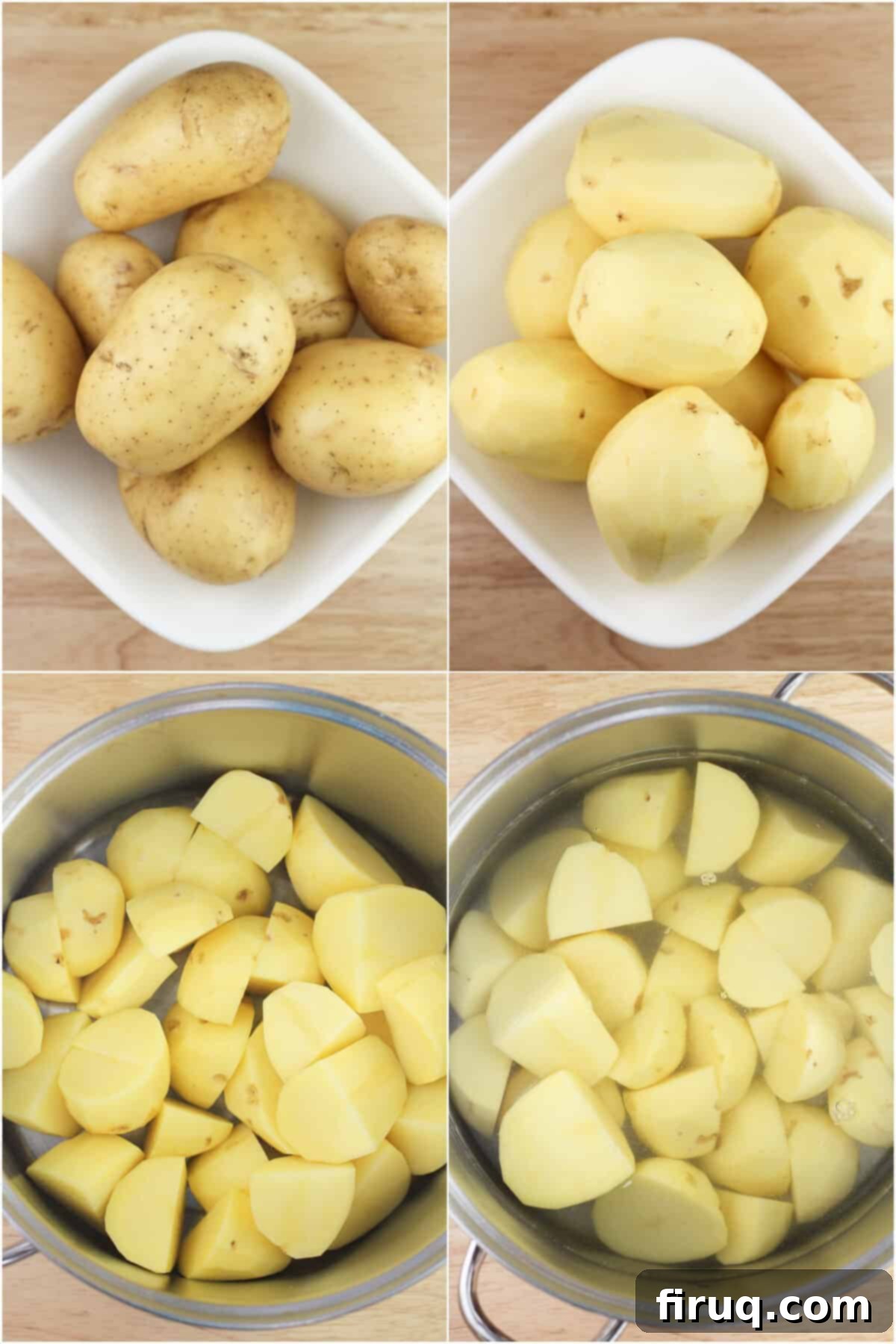
Step-by-Step: Crafting Your Cheesy Mashed Potatoes
Follow these detailed steps to create the most decadent and flavorful cheesy mashed potatoes your table has ever seen.
Preparing the Potatoes
First, we prepare our Yukon Gold potatoes for cooking. Begin by thoroughly peeling the potatoes. Once peeled, quarter them or cut them into roughly equal-sized pieces (smaller potatoes can simply be halved). Uniformity in size ensures even cooking. Place the cut potatoes into a large pot and cover them generously with cold water. Starting with cold water allows the potatoes to cook more evenly, as they heat up gradually with the water. Turn the burner to high heat, bringing the water to a gentle simmer, then reduce the heat and continue to simmer until the potatoes are perfectly fork-tender. Simultaneously, preheat your oven to 350°F (175°C).
Infusing the Butter with Garlic
While the potatoes are simmering, take a moment to prepare our flavorful garlic-infused butter. In a small saucepan, melt the unsalted butter over low heat. Add the chopped garlic and let it cook gently for just about one minute. This brief cook time is crucial: it infuses the butter with a rich garlic essence while taking the harsh raw edge off the garlic without browning it. This ensures that every bite of your mashed potatoes will carry that delightful, aromatic garlic flavor. Once infused, remove the saucepan from the heat and set it aside.
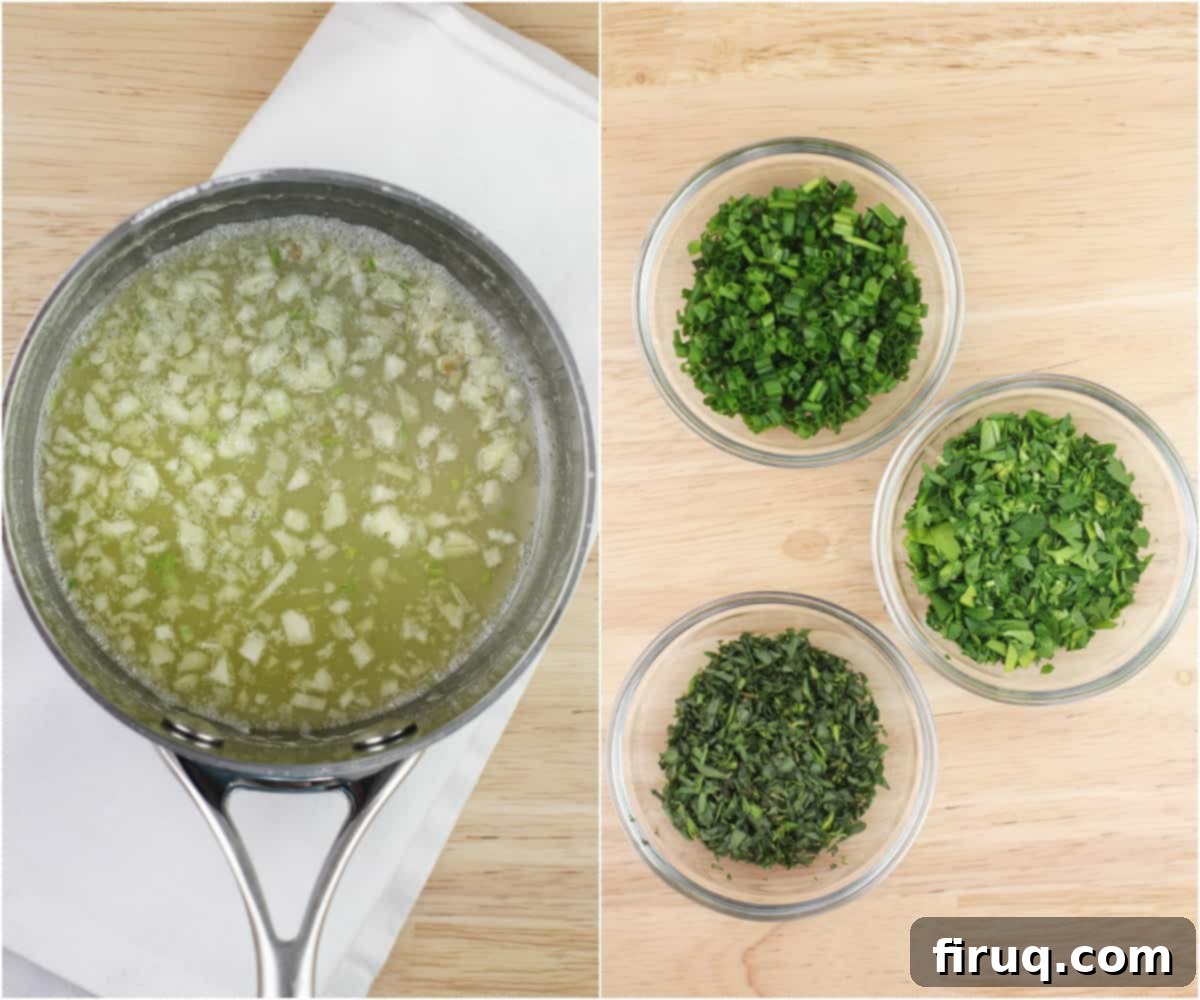
Mashing and Mixing
Once the potatoes are fork-tender, drain them thoroughly to remove all excess water. For the ultimate smooth and lump-free texture, I highly recommend using a potato ricer. Pass the drained potatoes directly through the ricer back into the empty pot. If a ricer isn’t available, return the drained potatoes to the pot and mash them with a traditional potato masher, aiming for as smooth a consistency as possible.
Now it’s time to incorporate the flavor powerhouses. Add the garlic-infused butter, heavy cream, milk, kosher salt, and fresh cracked pepper to the riced or mashed potatoes. Crucially, at this stage, add only about three-quarters of each of the shredded Gruyere and Gouda cheeses, and half of each of your fresh herbs (parsley, chives, and tarragon). Gently stir all the ingredients together until just combined. If a potato ricer was used, you’ll immediately notice the incredibly creamy, smooth texture of the mixture.
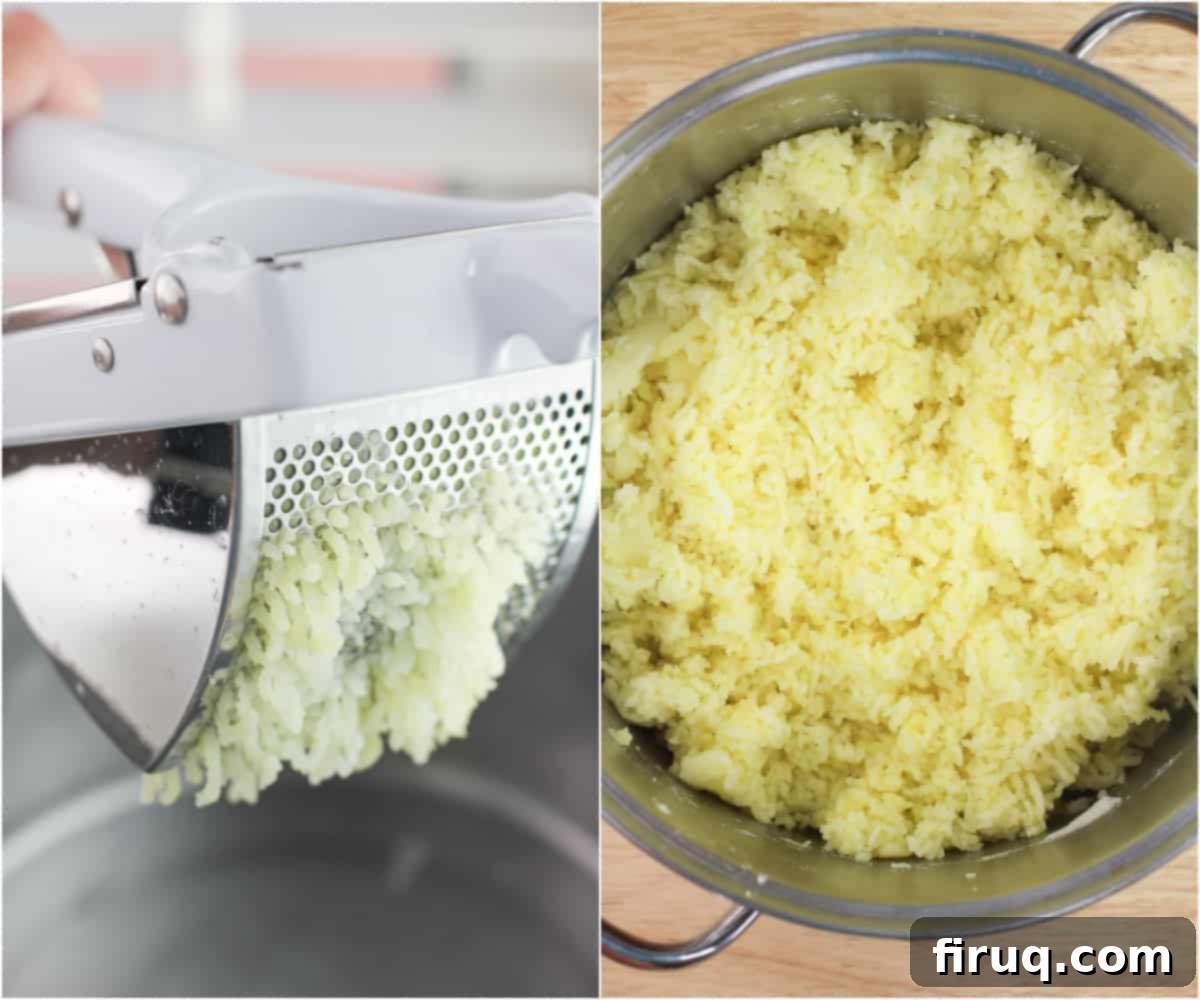
Seasoning and Baking
At this critical point – and this is KEY for perfect flavor – taste your mashed potatoes for seasoning. Adjust the salt content as needed, keeping in mind the inherent saltiness of the cheeses. If the potatoes seem a bit too thick, add a splash or two more milk until you reach your desired creamy, dreamy consistency. You’re aiming for perfectly seasoned and wonderfully creamy cheesy mashed potatoes.
Transfer your beautifully prepared mashed potatoes into a 2-quart casserole or baking dish. Sprinkle the remaining Gruyere and Gouda cheeses evenly over the top. Bake the dish in your preheated 350°F (175°C) oven for approximately 15-20 minutes, or until the cheese is melted, bubbly, and you can hear a gentle sizzle, indicating they are thoroughly heated and the cheese has achieved peak deliciousness. Finally, garnish with the remaining fresh herbs just before serving, adding a final touch of flavor and visual appeal. Enjoy!
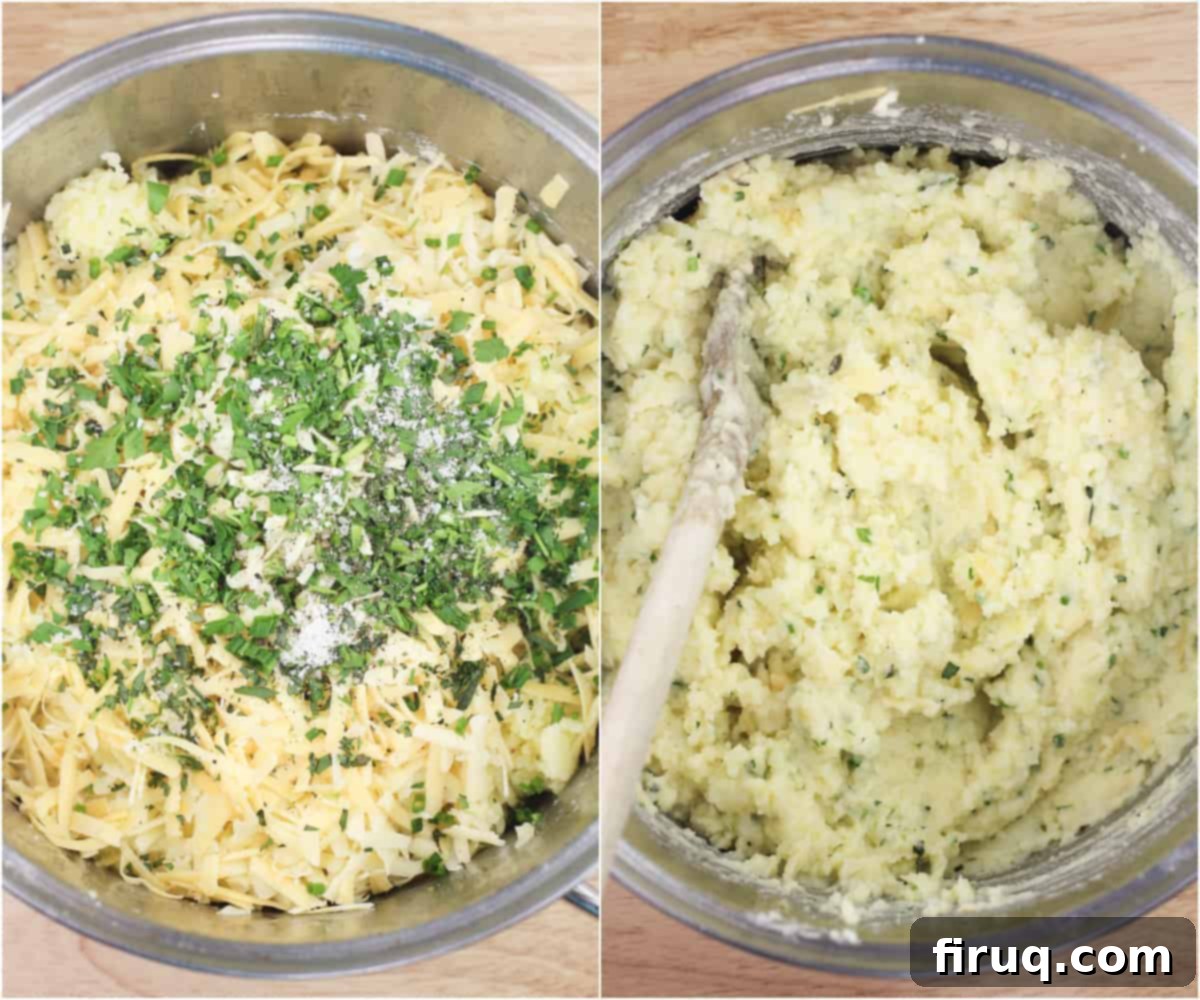
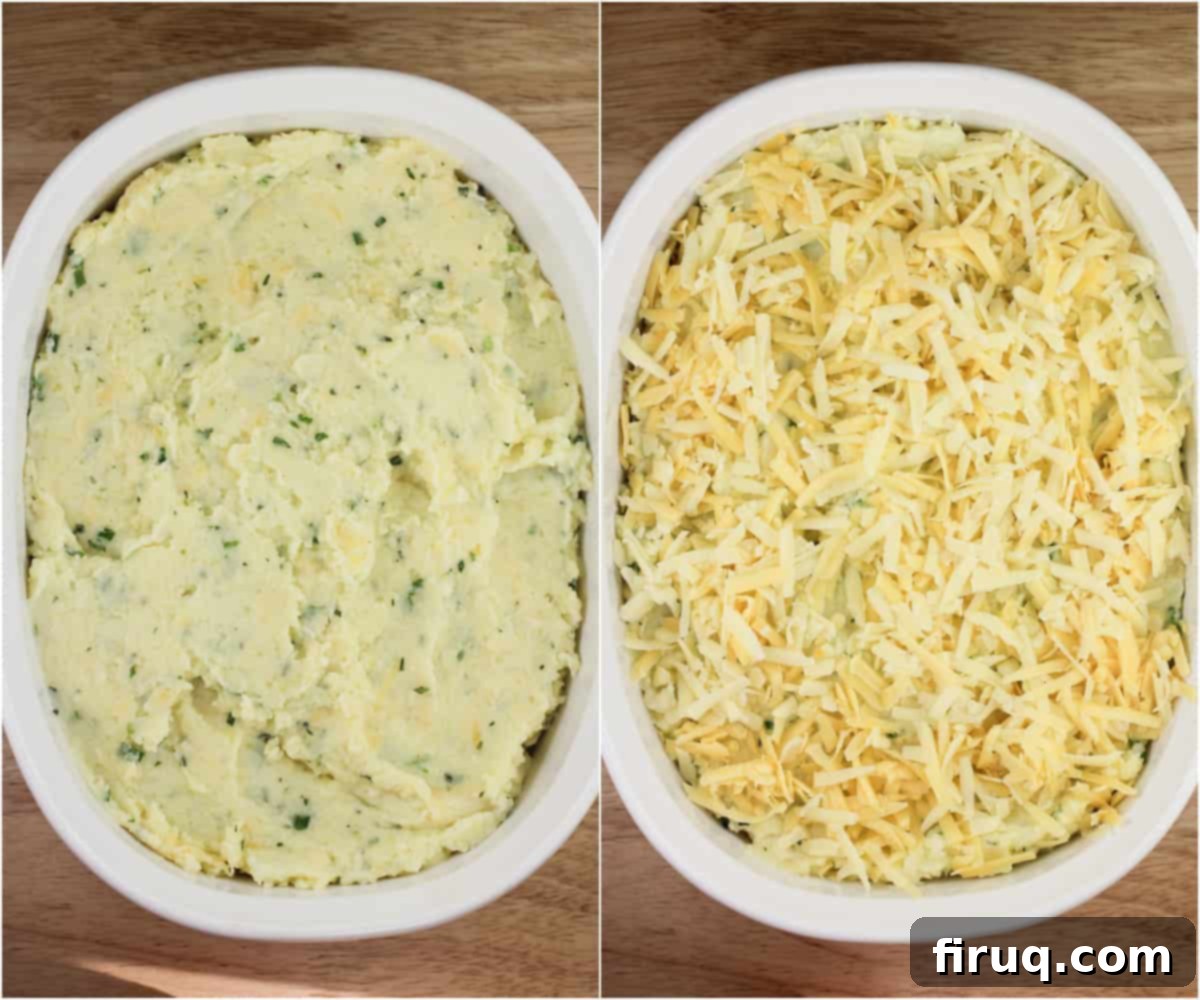
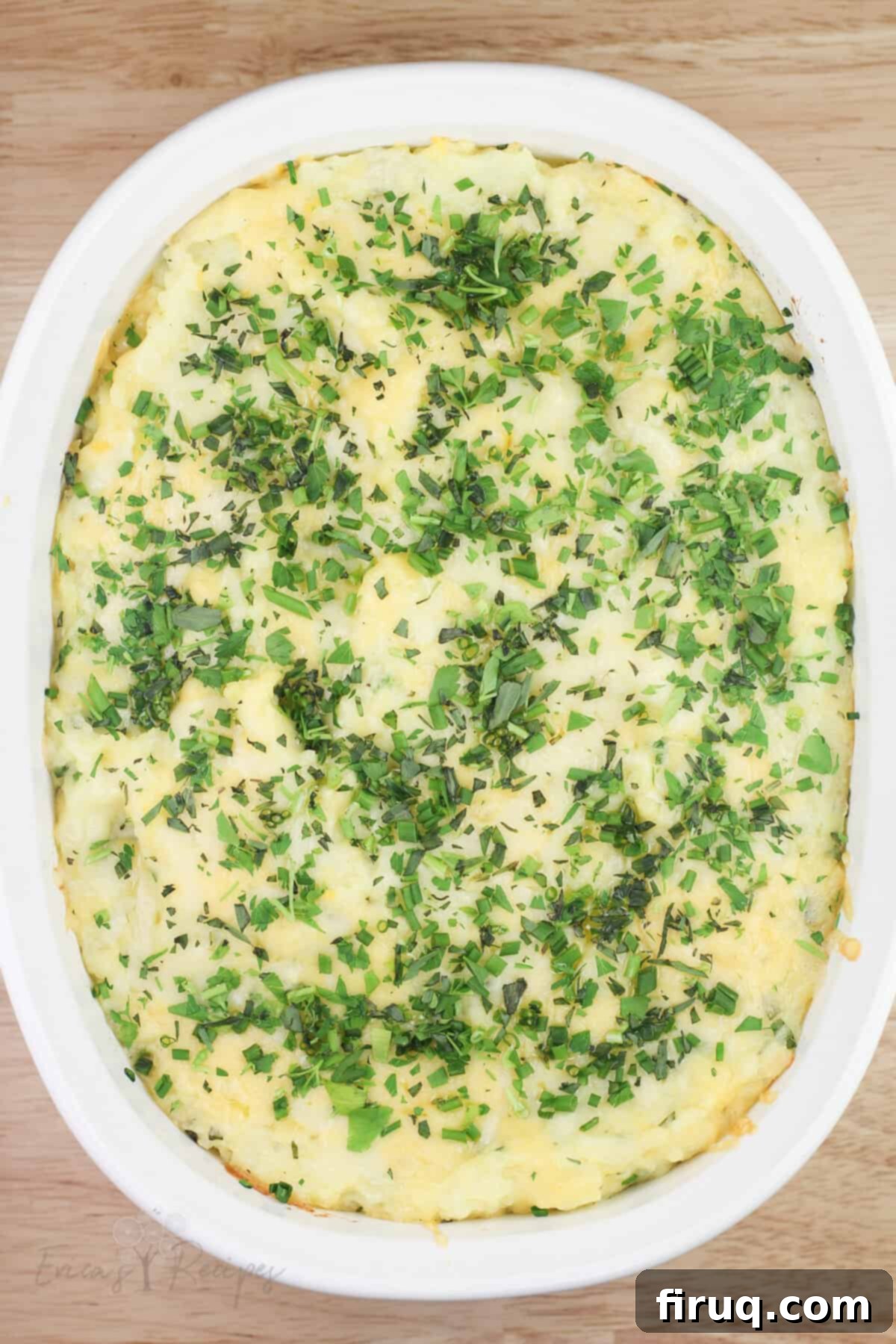
Frequently Asked Questions About Cheesy Mashed Potatoes
Peeling the potatoes for this recipe is primarily about achieving the smoothest possible texture. However, Yukon Gold potatoes have wonderfully thin, delicate skins, much like red potatoes. If you prefer a more rustic “smashed” potato style and don’t mind a slight textural difference, you can certainly leave the skins on. Just ensure they are thoroughly scrubbed clean before cooking.
While the traditional French fine herbs create a specific flavor profile, fresh herbs in general are always a fantastic addition. Flat-leaf parsley is usually readily available, but if you’re having trouble finding specific herbs like tarragon or chives, don’t despair! You can experiment with other mild, fresh herbs like thyme, marjoram, or even watercress. Arugula could also offer a peppery, fresh note. The key is to choose delicate flavors that won’t overpower the cheeses and garlic.
Absolutely! These cheesy potatoes are excellent for make-ahead meal planning. You can assemble them completely in advance, right up to the point of putting them in the baking dish and topping with the remaining cheese. Store them covered in the refrigerator. When you’re ready to serve, simply bake them in the oven until heated through and bubbly. I do not recommend fully cooking them ahead of time unless you can keep them warm until serving, as melted cheese tends to firm up as it cools, affecting the texture.
For transporting to a potluck or gathering, consider baking the mashed potatoes in a dish with a tight-fitting glass lid. This helps to keep them warm, moist, and protected during transit. If a glass lid isn’t available, cover the baking dish tightly with aluminum foil. For extended warmth, wrap the covered dish in a couple of kitchen towels – this insulation will help retain heat for a surprisingly long time, ensuring your potatoes arrive deliciously warm.
While Gruyere and Gouda are widely available, if you find yourself unable to source one, suitable substitutes exist. For Gouda, good alternatives include Muenster, Edam, or Fontina, all of which offer a similar semi-soft texture and mild, creamy flavor. For Gruyere, consider Comté, Emmental, or Jarlsberg; these hard, nutty cheeses will provide a comparable robust flavor. Regardless of your choice, always ensure you select unsmoked varieties to maintain the intended flavor profile of the dish.
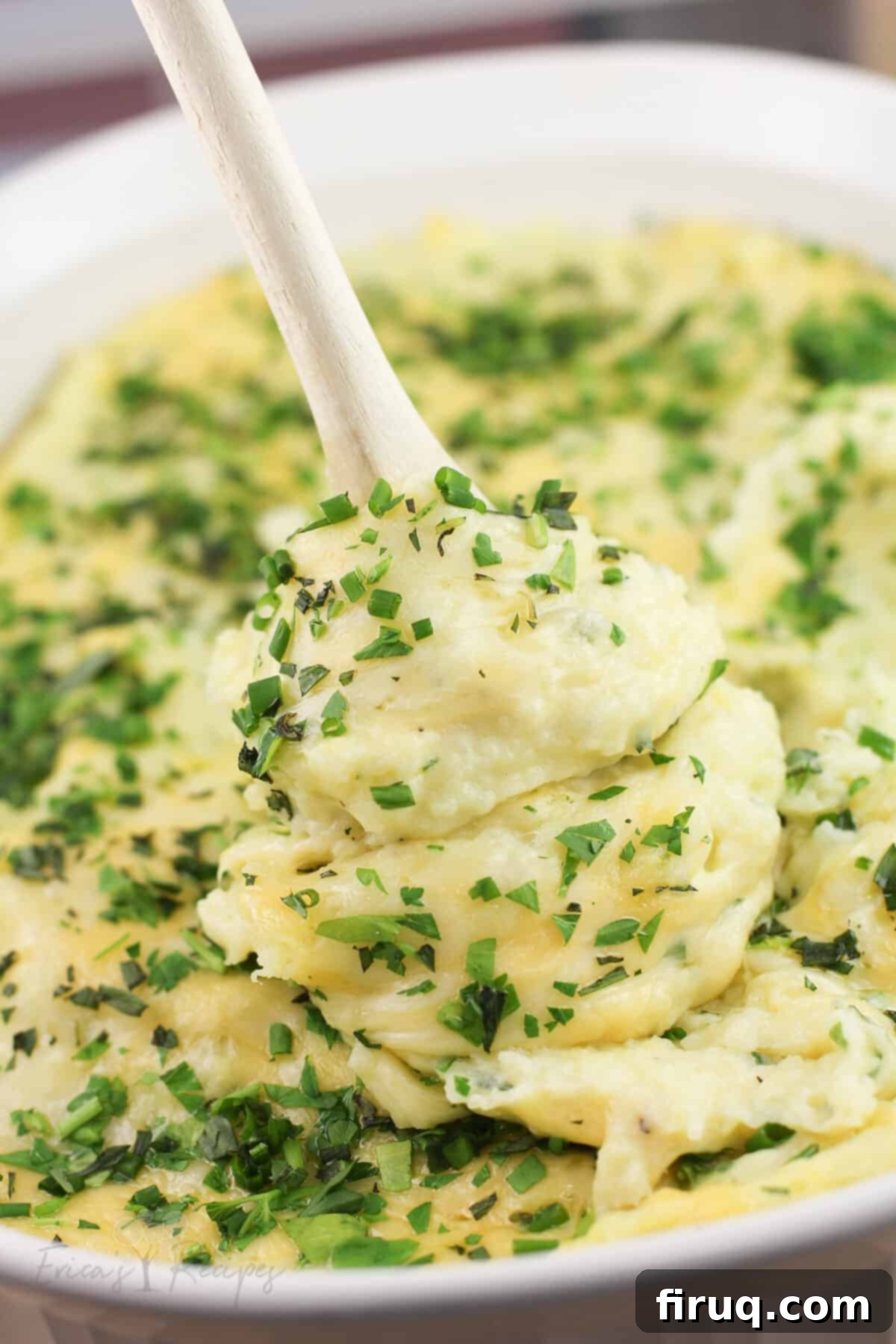
Expert Tips for the Most Flavorful Mashed Potatoes
Achieving perfectly creamy, flavorful mashed potatoes is an art, and these final tips will help you master it:
Peeling Yukon Gold Potatoes
Yukon Gold potatoes have incredibly thin skins, which means you need to be gentle when peeling them. Be mindful not to apply too much pressure with your vegetable peeler, as this can remove a significant amount of the potato flesh. Some peelers are sharper or designed to carve deeper, so if you have multiple, choose the one that offers the most delicate peel to maximize your yield and minimize waste.
Invest in a Potato Ricer
If you don’t already own a potato ricer, I wholeheartedly recommend considering this invaluable kitchen tool. It’s a game-changer for mashed potatoes, consistently producing a light, fluffy, and completely lump-free texture that simply can’t be achieved with a traditional masher. Beyond mashed potatoes, a ricer is incredibly versatile: use it to create smooth purees for other vegetables, prepare baby food, or even to squeeze excess water from cooked spinach, kale, or other greens before adding them to recipes. Its multifunctional nature makes it a winning addition to any kitchen.
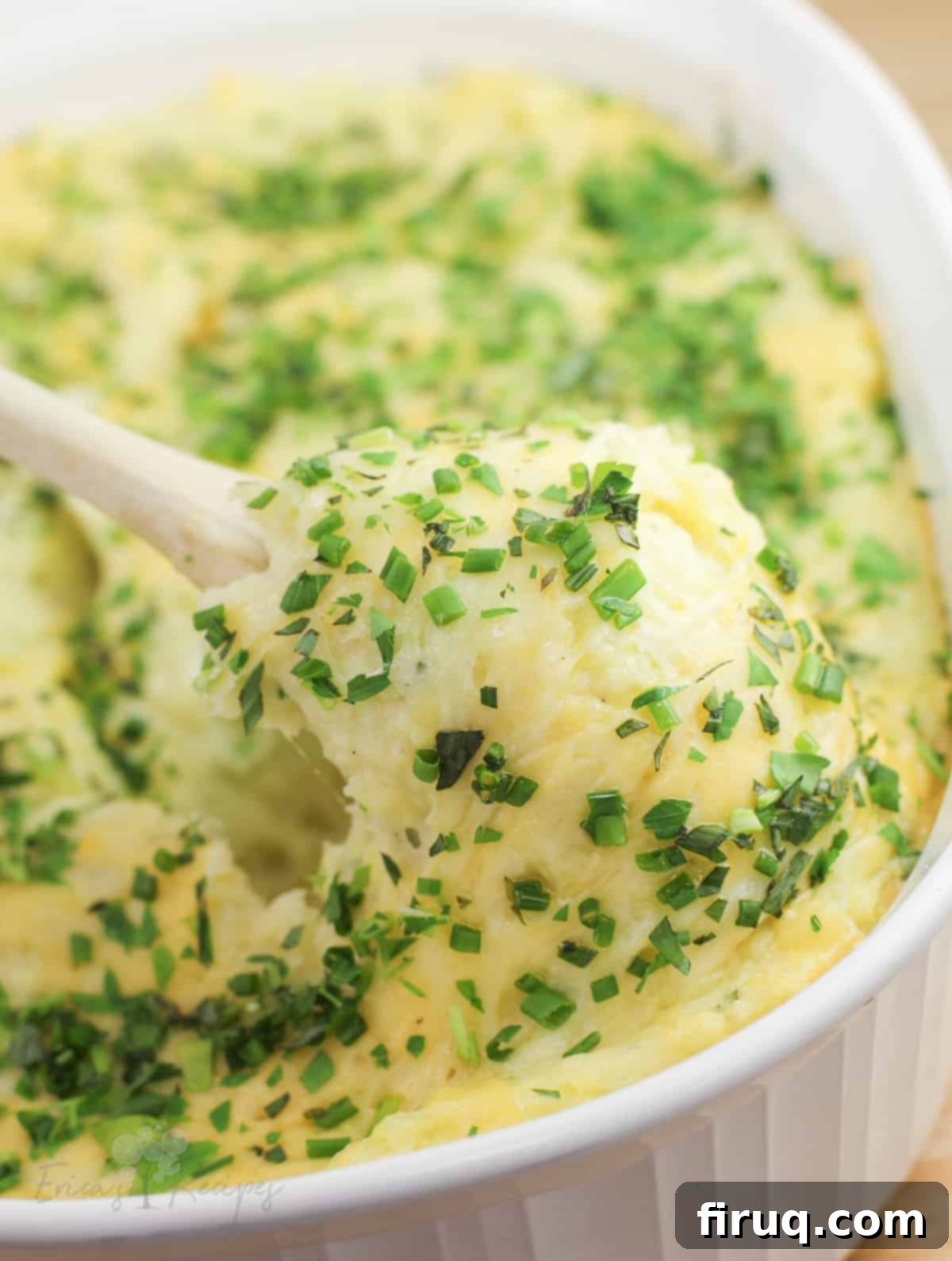
Shredding Cheese for Optimal Melt
When preparing the Gruyere and Gouda, use the large holes of your cheese grater. This creates thicker strands of cheese that melt beautifully and integrate smoothly into the potatoes, contributing to their rich, creamy texture. I find a sturdy standing box grater easiest for this task, as it allows you to apply pressure steadily for efficient shredding.
Achieving the Perfect Creaminess
The amount of milk required can fluctuate based on the specific moisture content of your potatoes, which can vary by batch. Don’t hesitate to add a little extra milk, perhaps an additional 1-2 tablespoons (a splash or two), until you reach your desired consistency. The goal is for a spoon to glide easily through the potatoes with minimal resistance, indicating a luscious, creamy texture.
The Importance of Tasting and Adjusting
Always, always taste your mashed potatoes before final serving. As both Gruyere and Gouda naturally contribute salt, it’s prudent to start with a lighter hand on the added kosher salt. Taste the mixture and then add more salt or pepper as needed to suit your personal preference. A perfectly seasoned dish is a delicious dish!
Mind Your Simmer, Not a Boil
When cooking your potatoes, resist the urge to crank the heat to a rolling boil. While it might seem faster, a violent boil causes the outside of the potato chunks to cook much faster than the inside, leading to uneven cooking and often mushy exteriors with harder cores. Instead, maintain a gentle simmer. This allows the potatoes to cook evenly throughout, ensuring they remain intact and tender without becoming waterlogged or falling apart prematurely – especially important if you plan to use a potato ricer for that ideal fluffy texture.
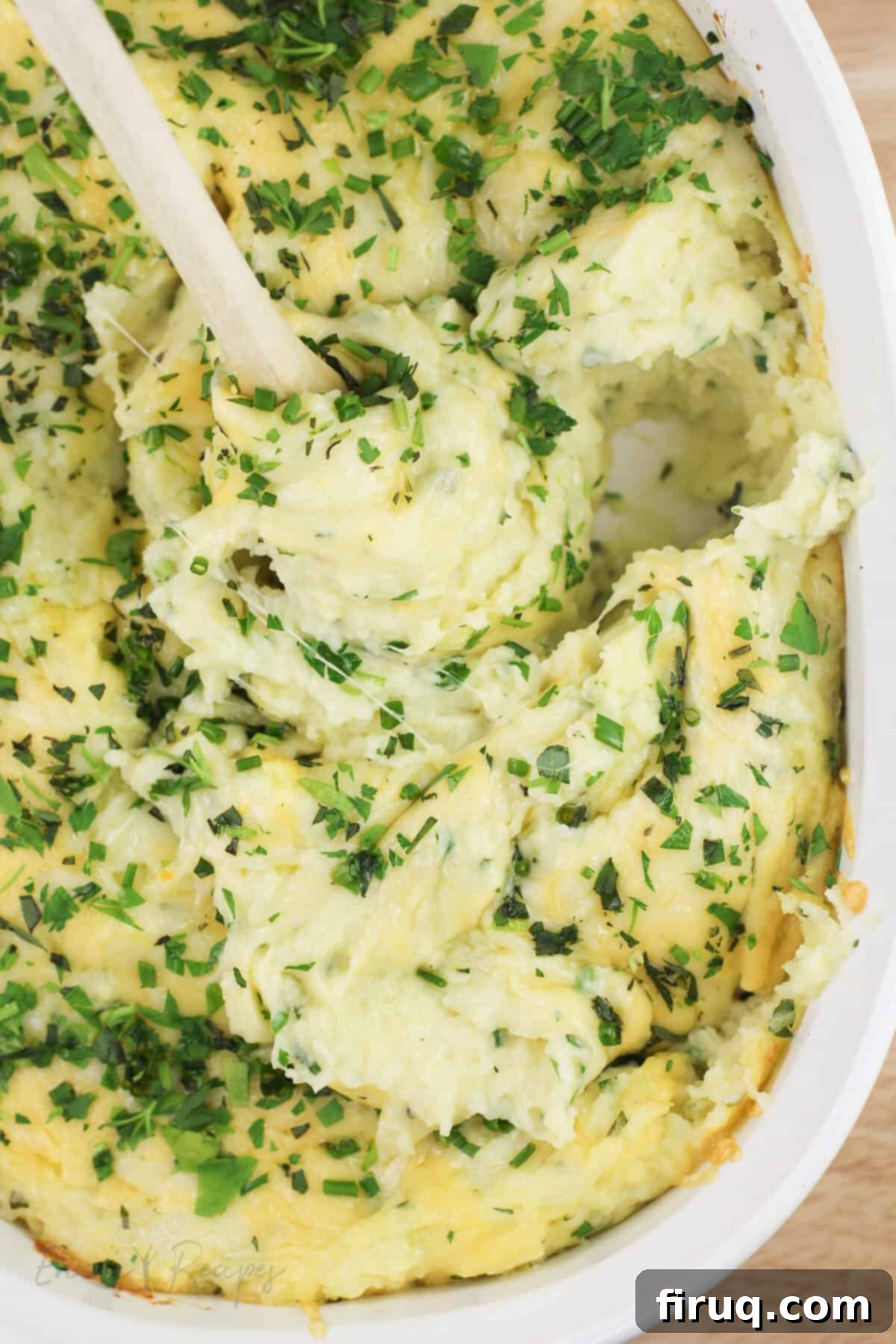
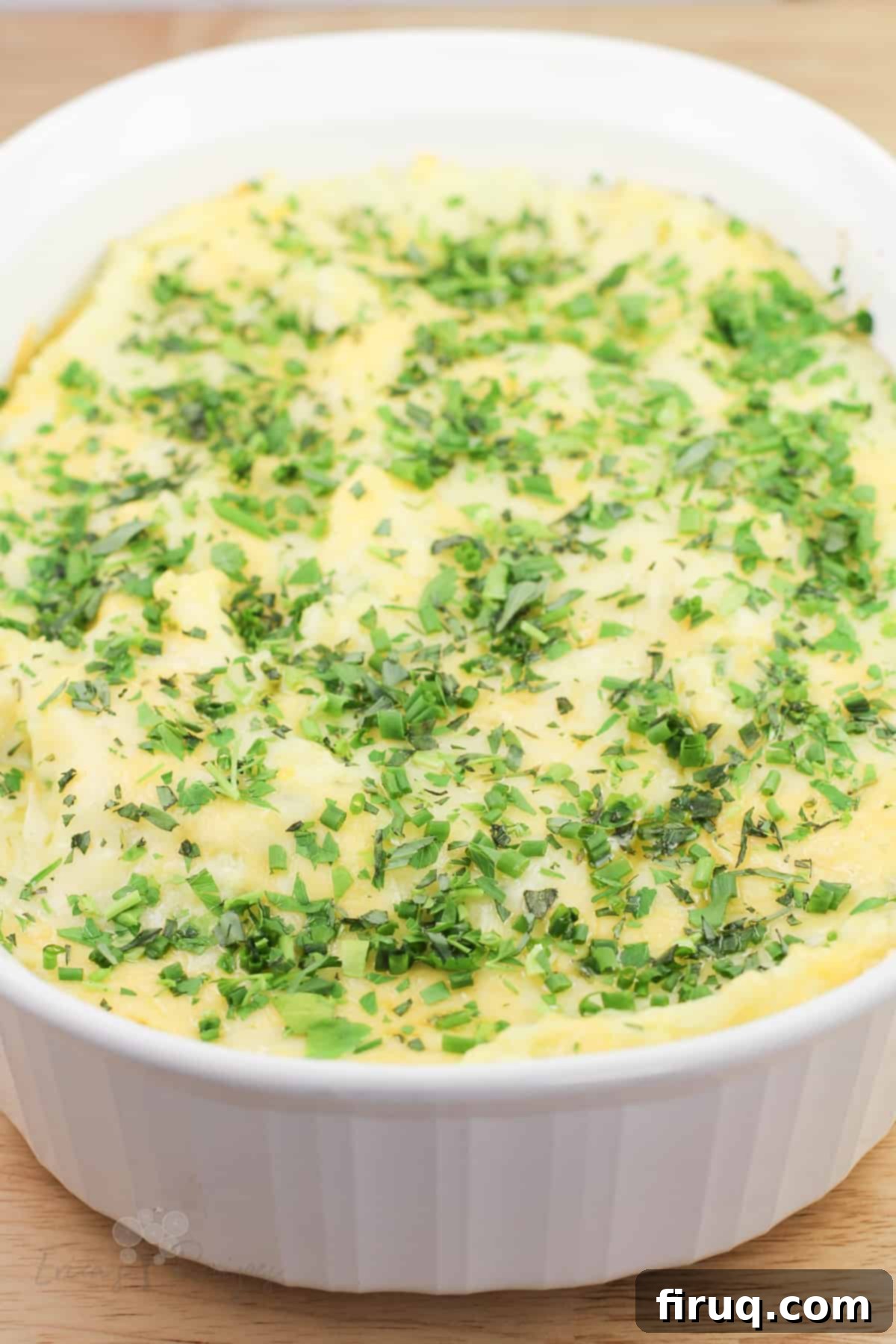
Gruyere, Garlic, and Gouda Mashed Potatoes
Print
Pin
Rate
Ingredients
- 2 ½ lbs Yukon gold potatoes peeled and quartered
- 2 Tbsp unsalted butter
- 2 clove garlic chopped
- ¼ cup heavy cream
- ½ cup milk
- 1 (5.3 oz) pkg Gruyere cheese, shredded and divided
- 1 (5.3 oz) pkg Gouda cheese, shredded and divided
- ½ tsp kosher salt
- 2 pinches fresh cracked pepper
- 2 Tbsp minced fresh flat-leaf parsley divided
- 2 Tbsp minced fresh chives divided
- 1 Tbsp minced fresh tarragon leaves divided
Instructions
-
Heat oven to 350°F (175°C).
Cook the potatoes
-
Place the peeled and quartered potatoes in a large pot and cover with cold water. Place the pot on a stove burner, turn to high heat, and bring the water to a simmer (this usually takes 5-6 minutes).
-
Reduce heat to medium-high and simmer the potatoes until they are just fork-tender (approximately 10-15 minutes). During this cooking time, adjust the heat as needed to maintain a gentle simmer, avoiding a violent rolling boil.
-
While the potatoes are cooking: in a small saucepan, melt the unsalted butter. Add the chopped garlic and cook gently for 1 minute to infuse the butter with garlic flavor and lightly soften the garlic. Remove from heat and set aside.
Assemble the mashed potatoes
-
Drain the potatoes very well, ensuring all water is removed. If using a potato ricer, pass the potatoes through the ricer directly back into the empty pot. If not using a ricer, return the drained potatoes to the pot and mash thoroughly.
-
Add the butter-garlic mixture, heavy cream, milk, three-quarters of both the shredded Gruyere and Gouda cheeses, salt, pepper, 1 Tablespoon each of minced parsley and chives, and 1/2 Tablespoon of minced tarragon. Stir all ingredients together gently until well combined.
-
Taste for seasoning and add a splash or two more milk if necessary to achieve your desired consistency of perfectly creamy mashed potatoes.
Bake and serve
-
Transfer the mashed potatoes to a 2-quart casserole or baking dish. Evenly top with the remaining Gruyere and Gouda cheeses.
-
Bake, uncovered, in the preheated oven at 350°F (175°C) for 15-20 minutes, or until the potatoes are thoroughly heated through and the cheese is melted, bubbly, and subtly sizzling. Garnish with the remaining fresh herbs just before serving and enjoy!
